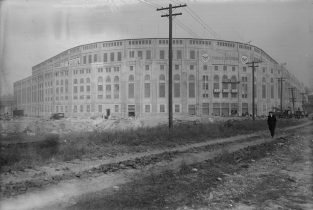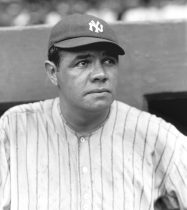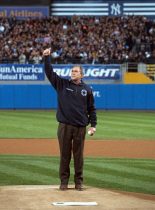Over the course of its history, Yankee Stadium has become more than a ballpark. Yankee Stadium has now become part of New York itself through its history, traditions, and the people that have walked through its gates. There are many points in the history of Yankee Stadium where it transcended the world of sports and entered into New York culture itself. The well-known traditions that have developed in Yankee Stadium have also become sought out attractions for any visitor to the ballpark. The people associated with Yankee Stadium fame have not just reshaped baseball but have also reshaped the culture in the city as a whole. Figures like Lou Gehrig have now become national icons and are now representative of New York sports culture. During an examination of the overall history of Yankee Stadium, even more of this New York history and culture will be revealed.

The lead-up to and eventual decision to build Yankee Stadium was a monumental event in New York history on its own. Before moving into Yankee Stadium, the New York Yankees had played at a ballpark in Manhattan called the Polo Grounds. The Yankees shared the Polo Grounds with another baseball team, the New York Giants, which often led to a tense relationship between the two organizations.[1] After the 1921 season, the Giants informed the Yankees that they had to vacate the Polo Grounds as soon as possible.[2] After receiving this decision, the Yankees began looking for a location to build a new stadium. The Yankees ultimately chose a plot of land in the West Bronx, which they purchased from William Waldorf Astor for $675,000.[3] The construction of Yankee Stadium was a very ambitious project and the scale of the stadium was something unheard of at that point in sports. The owners of the Yankees decided on a very ambitious plan to turn Yankee Stadium into the first triple-decker stadium in the country.[4] This grand scale often came into conflict with the city, but despite these setbacks Yankee Stadium was completed and ready for Opening Day in 1923.
Much like its construction, the first Opening Day at Yankee Stadium showed off the stadium’s grand scale and cultural impact. The New York Times described the moment by stating, “The greatest crowd that ever saw a baseball game sat and stood in this biggest of all baseball stadia.”[5] The New York Times ultimately gave the final attendance amount of 74,200 and also noted that over 25,000 people were turned away at the gates because of a sold out crowd.[6] The first game itself even included a moment where “Babe Ruth christened his new home with a three-run homer to cap a four-run third inning as the Yankees coasted to a 4-1 win,” which would often be a common trend during the stadium’s early history.[7]
The opening of Yankee Stadium introduced a huge cultural element into the city as attendance boomed at the new stadium during its first weeks of inception. Andrew Gordon Harrington describes this cultural boom in his article “The House that Cultural Capital Built: The Saga of the New Yankee Stadium” when he writes, “Even President Warren Harding felt the need to be seen at a Yankee game just a week after the stadium opened.”[8] These major events taking place at the new stadium helped support Harrington’s theory of a “cultural capital” developing at Yankee Stadium. An economic boom was taking place in the city and the Yankees “were now the biggest draw in baseball.”[9] The Yankees were transitioning from a baseball team into a brand, and the new stadium was at the center of it. Harrington explains that “on the surface, it is simply a building where the successful franchise has won many games, but it has developed its own cultural cache over time.”[10] He concludes by stating that the stadium became “a place to be and be seen.”[11] The opening of the stadium placed New York City as a whole in the limelight and provided yet another attraction in the city that people all over the country traveled to see.

One major reason for the popularity and attractiveness of Yankee Stadium was mostly due to one of its premier players, Babe Ruth. Immediately after the Yankees acquired Babe Ruth from their rivals, the Boston Red Sox, he began filling seats on his own as he introduced a new element of power hitting to baseball that had not been seen in the previous “Deadball” era of the game. Having this relatively new and exciting element of baseball was the perfect addition to the opening of a new stadium. Babe Ruth represented an almost perfect situation for the Yankees as he became an attraction himself, and he matched this attractiveness by providing the ownership of the team with success and financial reward. In his book, Pinstripe Empire, Marty Appel simply puts, “Ruth loved the Yankees, and the Yankees loved Ruth.”[12] The Yankees would continue to ride the success of Babe Ruth and assemble one of the greatest teams in baseball history that brought Yankee Stadium its first World Series in 1927.[13] This success and popularity being brought to Yankee Stadium, mostly through the actions of Babe Ruth, eventually led to the stadium gaining the nickname of “The House That Ruth Built.”[14] As the career of Babe Ruth continued, he began to transition from being a baseball icon to now being a historical icon. Appel explains his celebrity status when he states “Babe Ruth loved the spotlight and – with Charles Lindbergh, Charlie Chaplin, and whoever was president – was the biggest celebrity in the land.”[15] This trend of pushing past baseball relevancy into national relevancy would be an aspect found throughout the history of Yankee Stadium.
One crucial example of Yankee Stadium representing more than just sports is the life and career of Lou Gehrig. Lou Gehrig throughout his career had already become a legend in the eyes of Yankee fans, but in 1939 Gehrig entered the national stage as more than a symbol of baseball. On June 22, 1939, it was announced by the president of the Yankees that Lou Gehrig was diagnosed with a relatively unknown disease called amyotrophic lateral sclerosis.[16] A Yankee icon who had been playing baseball almost a month earlier, suddenly had his life in jeopardy. Lou Gehrig and this new disease were then thrust into the spotlight as Yankee Stadium hosted Lou Gehrig Appreciation Day on July 4, 1939.

During the course of the ceremony, Lou Gehrig gave his famous “Luckiest Man” Speech that is still used today as a symbol of hope for the people battling the disease that now bears his name. New York Times writer John Drebinger described the scene when he wrote “in perhaps as colorful and dramatic a pageant that as ever was enacted on a baseball field, 61,808 fans thundered a hail and farewell to Henry Lou Gehrig at the Yankee Stadium yesterday.”[17] Gehrig opened his speech by saying, “Today I consider myself the luckiest man on the face of the earth,” a line that is still a symbol for the fight against ALS.[18] This ceremony and speech solidified Lou Gehrig as a national icon and on January 7, 1940 the Yankees retired Gehrig’s jersey number from ever being used again.[19] Not only was he the first baseball player ever to have his jersey number retired, he was also the first of many Yankee players to be enshrined in a new outdoor museum at the stadium now known as Monument Park.[20] Sadly, Lou Gehrig finally succumbed to ALS on June 2, 1941 at the age of thirty seven.[21] Today, Lou Gehrig’s speech at Yankee Stadium continues to act as a beacon of hope and as a symbol of New York spirit and fortitude.
Yankee Stadium would never dismiss its role as a beacon of hope and it would have to be called upon on many occasions during difficult times in American history. One of these difficult times in American history was the period following the terrorist attacks on September 11, 2001. After the attacks, Americans were in need of a distraction from the tragedy and chaos that the country had been thrown into. Many people in New York and around the country looked to sports to provide this well-needed relief. On September 25, 2001, the Yankees played their first game at Yankee Stadium since the attacks and it turned into a game mixed with sadness, happiness, patriotism and most of all relief. Marty Appel described the return of New York baseball when he wrote “it had such an uplifting impact on New Yorkers who so needed to be able to smile again.”[22] Yankee Stadium began many patriotic practices throughout the rest of the 2001 season including the playing of Kate Smith’s version of “God Bless America” which is a tradition still held at Yankee Stadium today. After already providing immediate relief to New Yorkers, Yankee Stadium was once again placed on the national stage. On October 30, 2001, President George W. Bush arrived at Yankee Stadium to throw out the first pitch before the third game of the World Series.[23] This monumental event at Yankee Stadium provided much needed elements of strength and national unity during a time when it was needed most. Once again Yankee Stadium became more than a symbol of baseball. It became a symbol of the country as a whole.

Despite being a major symbol in New York City, Yankee Stadium was never without its faults and its fate often seemed to be in the balance. The first of these occasions came in 1972 when Yankee ownership and the City of New York debated over the fate of an almost fifty year old stadium.[24] The City of New York agreed to grant a new thirty year lease if the Yankees did a full modernization of the stadium.[25] This full modernization required the Yankees to temporarily move to Shea Stadium from 1974-1975. The new modernized stadium opened in 1976 and offered an apparent solution to the future of the stadium. In April 1998, the debate surrounding the fate of Yankee Stadium resumed when Yankees owner, George Steinbrenner, began arguing for a new stadium when “a five hundred-pound steel beam fell from the roof of Yankee Stadium and crushed a seat below.”[26] Even though the project was put on hold, the plans for a new stadium were finally approved in 2005. Eventually, the 2008 season was decided to be the final season played at the original Yankee Stadium. The second Yankee Stadium officially opened on April 3, 2009 for an exhibition game against the Chicago Cubs.[27] The demolition of the original, a stadium with many memories and symbolic meaning in New York City, was completed on May 13, 2010.[28]
Over the course of its eighty five year old history, the original Yankee Stadium came to be known as a lot more than just a sporting venue. It became a symbol of not just New York culture, but of American culture as well. Yankee Stadium has not only hosted legendary baseball players but also presidents of the United States and even the Pope.[29] Through its storied history and many monumental events, the original Yankee Stadium has built up a legacy that carries on through the new home of the Yankees. In the final speech held at Yankee Stadium, Derek Jeter reminded the Yankee fans, “There’s a lot of tradition, a lot of history, and a lot of memories,” which is a perfect summary of one of the greatest sporting venues in the country.
References
[1] “Yankee Stadium History,” http://newyork.yankees.mlb.com/nyy/ballpark/stadium_history.jsp (Accessed October 5, 2016)
[2] Ibid.
[3] Ibid.
[4] Marty Appel, Pinstripe Empire (New York: Bloomsbury, 2012), 125.
[5] New York Times. “74,200 See Yankees Open New Stadium; Ruth Hits Home Run,” New York Times, April 19, 1923.
[6] Ibid.
[7] “Yankee Stadium History,” http://newyork.yankees.mlb.com/nyy/ballpark/stadium_history.jsp (Accessed October 5, 2016)
[8] Andrew Gordon Harrington, “The House that Cultural Capital Built: The Saga of the New Yankee Stadium,” NINE: A Journal of Baseball History and Culture (2011): 78.
[9] Appel, 111.
[10] Harrington, 78.
[11] Harrington, 78-79.
[12] Appel, 132.
[13] Ibid., 151.
[14] “Yankee Stadium History,” http://newyork.yankees.mlb.com/nyy/ballpark/stadium_history.jsp (Accessed October 5, 2016)
[15] Appel, 220.
[16] Arthur J. Daley, “Infantile Paralysis Terminates Gehrig’s Playing Career,” New York Times, June 22, 1939.
[17] John Drebinger, “61,808 Fans Roar Tribute to Gehrig,” New York Times, July 5, 1939.
[18] Appel, 210.
[19] New York Times, “Yanks Never to Use Gehrig’s ‘No. 4’ Again,” New York Times, January 7, 1940.
[20] Appel, 418.
[21] New York Times, “Gehrig, ‘Iron Man’ of Baseball, Dies at the Age of 37,” New York Times, June 3, 1941.
[22] Appel, 518.
[23] Ibid., 520.
[24] “Yankee Stadium History,” http://newyork.yankees.mlb.com/nyy/ballpark/stadium_history.jsp (Accessed October 5, 2016)
[25] Ibid.
[26] Harrington, 81.
[27] Appel, 563.
[28] Appel, 562.
[29] “Yankee Stadium History,” http://newyork.yankees.mlb.com/nyy/ballpark/stadium_history.jsp (Accessed October 5, 2016
Bibliography
Appel, Marty. Pinstripe Empire. New York: Bloomsbury, 2012. Print. This book provides an overall history of the New York Yankees. Specific sections of focus are the founding of Yankee Stadium, Babe Ruth, and Lou Gehrig.
Daley, Arthur J., “Infantile Paralysis Terminates Gehrig’s Playing Career.” 1939. Ed. Dave Anderson. Story of the Yankees. New York: Black Dog & Leventhal, 2012. 98-99. Print. This New York Times article by Arthur J. Daley details the initial announcement of Lou Gehrig’s condition as well as the response.
Drebinger, John. “61,808 Fans Roar Tribute to Gehrig.” 1939. Ed. Dave Anderson. Story of the Yankees. New York: Black Dog & Leventhal, 2012. 99-102. Print. This article recaps the famous speech given by Lou Gehrig and focuses on many of the now famous lines of his speech.
Harrington, Andrew Gordon. “The House That Cultural Capital Built: The Saga of the New Yankee Stadium.” NINE: A Journal of Baseball History and Culture 19.2 (2011): n. pag. Project MUSE. Web. 2 Oct. 2016. In this Journal article, the author discusses the cultural impact of the old Yankee Stadium as well the creation of the new Yankee Stadium.
New York Times. “74,200 See Yankees Open New Stadium; Ruth Hits Home Run.” 1923. Ed. Dave Anderson. Story of the Yankees. New York City: Black Dog & Leventhal, 2012. 52-55. Print. A New York Times article that was written after opening day of Yankee Stadium.
New York Times. “Gehrig, ‘Iron Man’ of Baseball, Dies at the Age of 37.” 1923. Ed. Dave Anderson. Story of the Yankees. New York City: Black Dog & Leventhal, 2012. 103-104. Print. This New York Times article announces the death of Yankees legend Lou Gehrig.
New York Times. “Yanks Never to Use Gehrig’s ‘No. 4’ Again.” 1940. Ed. Dave Anderson. Story of the Yankees. New York City: Black Dog & Leventhal, 2012. 103. Print. This New York Times details the decision by the Yankees to retire Lou Gehrig’s jersey number.
“Yankee Stadium History.” Yankees.com. MLB.com, n.d. Web. 5 Oct. 2016. This article discusses the history of the old Yankee Stadium from the official website of the New York Yankees.